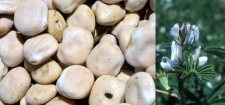La valorisation du lupin dans les filières animales
Utilisation of the lupin in animal sectors

Context
Animal production is heavily dependent on imported soybean meal as a dietary protein source. Europe’s dependence on US-produced soya makes it impossible to guarantee security of supply or freedom from contaminants or GMO. An EU plant protein autonomy scheme is therefore needed, particularly in connection with differentiated quality production. Furthermore, protein plant development is very much in line with a sustainable strategy. Such crops are indeed advantageous in terms of maintaining soil structure and are undemanding as regards input and plant protection products. The lupin, being richer in protein (36% DM) than the pea (24% DM) or the horse bean (28% DM) is the protein plant most likely to replace soybean meal in animal feeding.Objectives
The primary aim of the project is to examine the possibilities for substituting lupin for soybean meal as feed for animals kept for profit, such as dairy cows, double-muscled Belgian Blue bulls, growing and fattening pigs and broiler chicken. Secondly, the project aims to propose some feeding strategies to improve the utilisation of the lupin and/or increase the maximum quantities that can be added to animal feed. Results obtained
The results of the first study showed that the lupin (seeds) can completely replace soybean meal in high-production dairy cow feed, provided that the seed is distributed in coarsely ground form. The ideal particle size in terms of limiting rumen degradability while optimizing nutrient digestibility in the small intestine was determined to 4.0 mm, corresponding to a coarse grinding. Another trial established the main conditions for mixed lupin/maize silage, which was found to have an appreciably higher nutritional value than conventional forage and enabling a considerable saving of protein concentrates for similar productions levels. Lupin protein also has similar qualities to soybean meal for pigs at the growing/fattening stage, but some components acting as an anti-nutritional factor, such as α-galactosides, can restrict the animals’ production performance. These molecules affected essentially the animals with a live weight lower than 50 kg. In presence of galactosidase, results showed that the variety "Lublanc" was adapted to the pig feeding. To our knowledge, no economical way is existing to neutralized them. Finally, the lupin offers only a partial substitute for soybean meal in poultry feed, due to its richness and the chemical complexity of the fibres. Additional mix of enzymes in the diets did not improve the lupin valorization by broiler chicken. Contribution
Project leader – coordinatorPartners
o Gembloux Agricultural University, Animal Science Unit and Industrial Biochemistry Unit o ENESAD, Dijon, France CRAW off coordinator
CRA-WFunding




